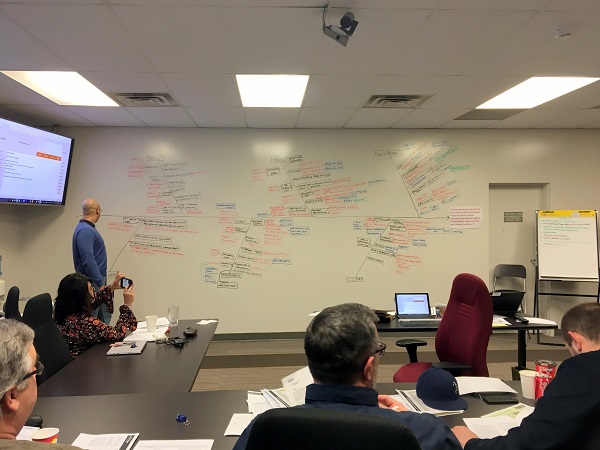
Impairment top health and safety risk in Ontario sawmills
Top 10 causes of substance use in Ontario sawmills - please download, share and discuss in your workplace
One of the benefits of the legalization of cannabis in Canada is that companies are taking a closer look at their health and safety policies and procedures and better addressing a longstanding yet rarely discussed concern as a cause of injury and death: substance use in the workplace.
Whether it’s prescription or recreational substance use, the business world does not measure workplace injury and fatality statistics with this crucial element in mind. The suggestion to create a toxicology database is just one of the many new controls suggested by a group of industry experts as they announce the results of an in-depth research project: root-cause analysis of substance use in the workplace.
Two years of research, consultation and validation with industry participants
In June 2017, a volunteer group of industry subject matter experts met face-to-face to conduct a workplace risk assessment for Ontario sawmills at Workplace Safety North (WSN) headquarters in North Bay, Ontario. The group of 15 representatives from management, labour, government, and not-for-profit organizations, was facilitated by Sujoy Dey, Ph.D., Corporate Risk Officer at the Ministry of Labour (MOL). In advance of the workshop, each industry expert submitted their top health and safety concerns, and during the one-day workshop, more than 80 identified risks were reviewed and discussed by the group.
Identifying leading indicators
“Using the risk assessment method and analyzing its root causes within the workplace is an extremely effective method to understand and identify leading indicators that allow industry to work more proactively in addressing key concerns,” says Dr. Dey.
Following review and discussion, both industry labour and management voted that the top risk was substance use: “Inappropriate use of alcohol, prescription, and recreational drugs can have serious unintentional adverse effects on workplace safety and the well-being of workers.”
One year later, in June 2018, a group of industry experts met for two days to determine the root causes of substance use in the workplace, and to develop critical controls and specific activities that could be put in place to address the identified issue.
Top 10 causes of substance use in Ontario sawmills
-
Lack of preventative tools - policies and procedures, testing, communication.
-
Ineffective communication at the workplace on this topic.
-
No current consensus from governing bodies on safe limits for consuming cannabis or prescription drugs (unlike alcohol).
-
Personal factor variability - substance use affects people differently.
-
Lack of policies and procedures including lack of clarity, effectiveness and communication, if any.
-
Lack of management support on this issue – unclear understanding and expectation from management (e.g. training needs, supervision, awareness).
-
Lack of quality training for supervisors (regarding cannabis and human rights legislation).
-
THC content and drug interaction can vary.
-
Social acceptance.
-
No root-cause statistics on how substance use affects workplace incidents – lack of information and data.
For more detailed information on the top causes of substance use in sawmills, please see accompanying technical paper.
Controlling for the hazard
Next, the group of subject matter experts got down to work by sharing best practices as a way to begin the development of controls and supporting activities that could be put in place to address substance use in the workplace.
“Ever since the group determined substance use was a top risk – something that is not measured or reported by Workplace Safety and Insurance Board – this dedicated group has worked very hard to share best practices and proposed controls that may be helpful to other industries,” says Tom Welton, WSN General Prevention Services Director.
“In our discussions, similar themes kept coming up: the need for effective policies and procedures, and for regular, effective communication around those policies and procedures. It’s time for workplaces to get talking about these issues in order to reduce stigma about substance use and to provide a supportive work environment.
“It’s important to get supervisors trained so they’re comfortable dealing with the issue. I hope this groundbreaking work will help guide industry in helping make workplaces safer,” adds Welton. “There is specialized training for supervisors on recognizing and dealing with substance use in the workplace.”
What workplaces can focus on immediately
Based on a scan of controls identified for the top 10 primary causal factors, it is beneficial, as a start, to focus right away on the following five common mitigation actions (current systemic weaknesses)
A. Clearly defined, effective, well-written and well-communicated policies
B. Specific training for supervisors on recognizing and dealing with impairment
C. Basic awareness training to all in the workplace (including how to recognize impairment)
D. Inventory of safety-sensitive job tasks, which is reinforced through written policy
E. Training for management and supervisor to communicate effectively (leadership program)
To learn more about the critical controls you can put in place to help prevent impairment in the workplace, read the technical paper Root cause analysis report of substance use in Ontario sawmills.
Related
Substance use top health and safety risk in Ontario sawmills - Workplace Safety North
Technical Paper: Root cause analysis report of substance use in Ontario sawmills
Is your workplace drug and alcohol policy up to date? – WSN
IWH work on provincial review supports new mining safety culture and systems audit tool – Institute for Work and Health
